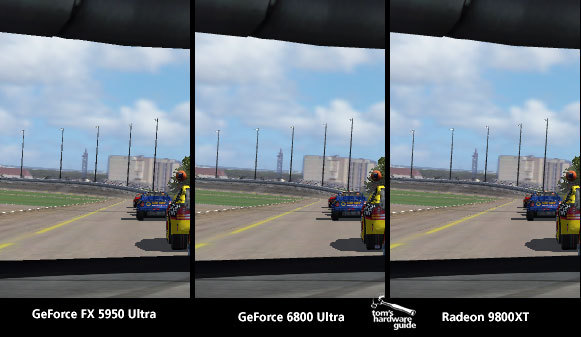Performance Leap: NVIDIA GeForce 6800 Ultra
Image Quality - FSAA
All screenshots in the following comparisons were taken at a resolution of 1024x768 pixels. We suggest that you set your desktop to that resolution to see the differences!
Let's start the image quality section off with FSAA. One application in which FSAA really pays off is racing games. Let's take a look at image quality in Nascar Thunder 2004:
All cards with 4x FSAA
This example makes it very clear that NVIDIA has finally caught up with ATI where FSAA quality is concerned with the GeForce 6800 Ultra. Comparing the image it produces to that of the 9800XT,we can only find minimal differences at the bottom part of the windshield frame. ATi's cards benefit from the gamma-corrected FSAA implementation here. The streetlight shows the FX 5950 Ultra's comparative inferiority.
The following comparison shows the advantages of NVIDIA's mixed FSAA modes, which use a combination of super sampling and multi sampling. The fence, shadows as well as the cars and some other elements look much smoother. The drawback is that this mode is very performance hungry (see benchmarks).
At the same sampling rate, the Radeon 9800XT and the GeForce 6800 Ultra offer practically identical quality. On ATi cards, the image quality can be further improved by using the 6x FSAA mode. NVIDIA counters this with its mixed-FSAA modes, which are very performance intensive but offer the highest possible image quality.
For comparison, here is a look at the GeForce 6800 Ultra's FSAA performance in UT 2004 at 1600x1200 for comparison:
Get Tom's Hardware's best news and in-depth reviews, straight to your inbox.
Current page: Image Quality - FSAA
Prev Page FarCry, Continued Next Page Image Quality - Anisotropic

